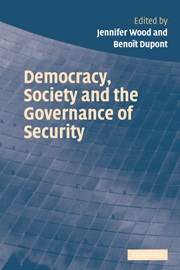Book contents
- Frontmatter
- Contents
- List of contributors
- Foreword
- Acknowledgements
- Introduction: Understanding the governance of security
- 1 Reflections on the refusal to acknowledge private governments
- 2 Transnational security governance
- 3 Two case studies of American anti-terrorism
- 4 Power struggles in the field of security: implications for democratic transformation
- 5 Policing and security as ‘club goods’: the new enclosures?
- 6 The state, the people and democratic policing: the case of South Africa
- 7 Necessary virtues: the legitimate place of the state in the production of security
- 8 From security to health
- 9 Research and innovation in the field of security: a nodal governance view
- Conclusion: The future of democracy
- References
- Index
3 - Two case studies of American anti-terrorism
Published online by Cambridge University Press: 22 September 2009
- Frontmatter
- Contents
- List of contributors
- Foreword
- Acknowledgements
- Introduction: Understanding the governance of security
- 1 Reflections on the refusal to acknowledge private governments
- 2 Transnational security governance
- 3 Two case studies of American anti-terrorism
- 4 Power struggles in the field of security: implications for democratic transformation
- 5 Policing and security as ‘club goods’: the new enclosures?
- 6 The state, the people and democratic policing: the case of South Africa
- 7 Necessary virtues: the legitimate place of the state in the production of security
- 8 From security to health
- 9 Research and innovation in the field of security: a nodal governance view
- Conclusion: The future of democracy
- References
- Index
Summary
Introduction
The recent scholarly interest in terrorism and anti-terrorism as a social problem exemplifies how politics and political interests shape research. The most penetrating and lucid work is the Report of the 9/11 Commission (2004). Clearly, control of, and response to, terrorism is a question of relevance to police studies, to the governance of security, and speaks to the fragmentation and multiplicity of forms of social control. Simultaneously, the power of the state has grown (Cohen 1985; Garland 2001; Johnston and Shearing 2003). Contemporaneous studies of social control agents and agencies provide data that can connect organizational theories, the negative risks associated with terrorism, and observable police actions in respect to putative terrorism and/or anti-terrorism. The emerging role of private and public police and anti-terrorism preparations are particularly revealing of the changing shape of control because terrorist policing and anti-terrorist policing, with some exceptions, have previously been eschewed by Anglo-American police (Liang 1993; Manning 2003: 41–2). Implicit in these developments is the question of to what degree these preparations threaten democratic freedoms and civil liberties.
This chapter, drawing on ethnographic-evidence studies of organizational responses to terrorism, has three themes. The first theme is that contingencies imagined as negative risks are not shared within and across policing (regulatory) organizations. The second concerns the problems associated with assembling temporary organizational networks to defend an event, place, or group at risk.
- Type
- Chapter
- Information
- Democracy, Society and the Governance of Security , pp. 52 - 85Publisher: Cambridge University PressPrint publication year: 2006
- 18
- Cited by



